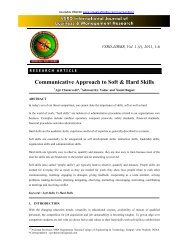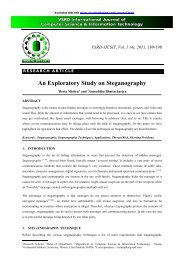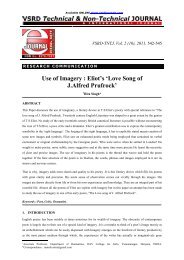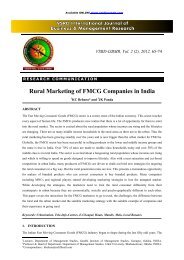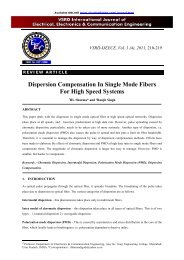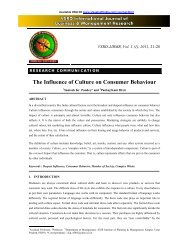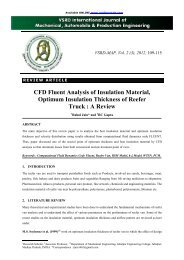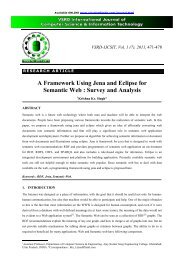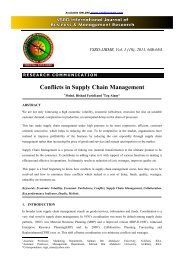Employee Drives & Role of Motivational Factors - vsrd international ...
Employee Drives & Role of Motivational Factors - vsrd international ...
Employee Drives & Role of Motivational Factors - vsrd international ...
You also want an ePaper? Increase the reach of your titles
YUMPU automatically turns print PDFs into web optimized ePapers that Google loves.
Available ONLINE www.visuals<strong>of</strong>tindia.com/journal.html<br />
VSRD-IJBMR, Vol. 1 (4), 2011, 253-261<br />
R E S E A R C H A R T II C L E<br />
<strong>Employee</strong> <strong>Drives</strong> & <strong>Role</strong> <strong>of</strong> <strong>Motivational</strong> <strong>Factors</strong><br />
1 Prahlad Prasad*<br />
ABSTRACT<br />
It is important to research and study the needs, drives, motivation and expectations <strong>of</strong> people we hire or employ,<br />
and aim at responding to and satisfying those, as it is with regard to customers. The study examined the ranked<br />
importance <strong>of</strong> drives and motivational factors <strong>of</strong> employees in organization. This addressed drives and<br />
motivation factors in the context <strong>of</strong> employee motivation theory. Finding suggest that inner drives like job<br />
security, interesting work and motivational factors like good pay/wages etc. are key to higher motivation.<br />
Carefully designed reward system i.e. job enlargement, job enrichment, promotions, internal and external<br />
stipends, monetary and non-monetary compensation, specific needs, drives, aspirations, capabilities, securities,<br />
self development, plan for future, expectations etc. should be considered.<br />
Keywords: <strong>Employee</strong> Motivation, <strong>Motivational</strong> Theories, Idea Generation, HRGI, S<strong>of</strong>t Issues.<br />
1. INTRODUCTION<br />
At one time employees were considered just as input into the production <strong>of</strong> goods and services.<br />
What perhaps changes this way <strong>of</strong> thinking about employees was research, referred to as the Hawthorne Studies,<br />
conducted by Elton Mayo from 1924 to 1932 (Dickson, 1973).This study found employees are not motivated<br />
solely by money and employee behaviour is linked to their attitudes (Dickson,1973). This Hawthorne Studies<br />
began the human relations approach to management, whereby the needs and motivation <strong>of</strong> employees become<br />
the primary focus (Bedeian, 1993). Motivation is a highly complex phenomenon (Bent, et al., 1999) that<br />
influences and is influenced by a large number <strong>of</strong> factors in the organisational environment (Porter and Steers,<br />
1991). The study <strong>of</strong> motivation is concerned with why individuals think and behave as they do (Mullin, 1999;<br />
Weiner, 1992; Wagner, 1999). A great amount <strong>of</strong> definitions are presented by literature, e.g. Vignali (1997)<br />
points out that motivation are a process that triggers individuals to act as they do. Analoui (2000) sees<br />
motivation as a drive within the individual necessary to direct that person's actions and behaviour towards the<br />
____________________________<br />
1 Research Scholar, Department <strong>of</strong> Management & Commerce, Singhania University, Jhunjhunu, RAJASTHAN, INDIA.<br />
*Correspondence: prahladprasad79@gmail.com
Prahlad Prasad et. al / VSRD International Journal <strong>of</strong> Business & Management Research Vol. 1 (4), 2011<br />
achievement <strong>of</strong> some goals, and focuses, according to Luthans (1995) and Mullins (1999), on the fulfilment <strong>of</strong><br />
certain needs and expectations. Moreover, Westerman and Donoghue refer to motivation as:<br />
"…a set <strong>of</strong> processes which energize a person's behaviour and direct him or her towards attaining some goal, or<br />
put more simply getting people to do willingly and well those things which have to be done." (1989, p. 79).<br />
Generally, motivation deals with forces, which initiate, direct and sustain behaviour towards the attainment <strong>of</strong><br />
certain goals (Bent et al., 1999).<br />
2. MOTIVATION DEFINED<br />
The psychological process that gives behaviour purpose and direction (Kreitner, 1995); a predisposition to<br />
behave in a purposive manner to achieve specific, unmet needs (Buford, Bedeian, & Linder, 1995; an internal<br />
drive to satisfy an unsatisfied need (Higgins, 1994); and will to achieve (Bedeian, 1993).<br />
3. MOTIVATION IS THE KEY TO PERFORMANCE IMPROVEMENT<br />
There is an old saying you can take a horse to the water but you cannot force it to drink; it will drink only if it's<br />
thirsty - so with people. They will do what they want to do or otherwise motivated to do. Whether it is to excel<br />
on the workshop floor or in the 'ivory tower' they must be motivated or driven to it, either by themselves or<br />
through external stimulus. Are they born with the self-motivation or drive Yes and no. If no, they can be<br />
motivated, for motivation is a skill which can and must be learnt. This is essential for any business to survive<br />
and succeed.<br />
Performance is considered to be a function <strong>of</strong> ability and motivation, thus:<br />
Job performance =f(ability)(motivation)<br />
Ability in turn depends on education, experience and training and its improvement is a slow and long process.<br />
On the other hand motivation can be improved quickly. There are many options and an uninitiated manager may<br />
not even know where to start. As a guideline, there are broadly seven strategies for motivation.<br />
<br />
<br />
<br />
<br />
<br />
<br />
<br />
Positive reinforcement / high expectations<br />
Effective discipline and punishment<br />
Treating people fairly<br />
Satisfying employees needs<br />
Setting work related goals<br />
Restructuring jobs<br />
Base rewards on job performance<br />
These are the basic strategies, though the mix in the final 'recipe' will vary from workplace situation to situation.<br />
Page 254 <strong>of</strong> 261
Prahlad Prasad et. al / VSRD International Journal <strong>of</strong> Business & Management Research Vol. 1 (4), 2011<br />
Essentially, there is a gap between an individual’s actual state and some desired state and the manager tries to<br />
reduce this gap.<br />
4. MOTIVATION THEORISTS AND THEIR THEORIES<br />
Although the process <strong>of</strong> management is as old as history, scientific management as we know it today is basically<br />
a twentieth century phenomenon. Also, as in some other fields, practice has been far ahead <strong>of</strong> theory. This is<br />
still true in the field <strong>of</strong> management, contrary to the situation in some <strong>of</strong> the pure sciences. For instance, Albert<br />
Einstein, formulates a theory, which is later proved by decades <strong>of</strong> intensive research and experimentation. Not<br />
so in the field <strong>of</strong> management.<br />
In fact this field has been so devoid <strong>of</strong> real fundamental work so far, that Herbert A. Simon is the first<br />
management theoretician to win the Nobel Prize for Economics in 1978. His contribution itself gives a clue to<br />
the difficulty, bordering on impossibility, <strong>of</strong> real fundamental work in this field concerned with people. In order<br />
to arrive at a correct decision, the manager must have all the information necessary relevant to the various<br />
factors and all the time in the world to analyze the same. This is seldom, if ever, the case. Both the information<br />
available and the time at the managers’ disposal are limited, but he or she must make a decision. And the<br />
decision is, therefore, not the optimum one but a 'satisfying' one - in effect, a satisfactory compromise under the<br />
real conditions prevailing in the management 'arena'.<br />
4.1. Traditional theory 'X'<br />
This can best be ascribed to Sigmund Freud who was no lover <strong>of</strong> people, and was far from being optimistic.<br />
Theory X assumes that people are lazy; they hate work to the extent that they avoid it; they have no ambition,<br />
take no initiative and avoid taking any responsibility; all they want is security, and to get them to do any work,<br />
they must be rewarded, coerced, intimidated and punished. This is the so-called 'stick and carrot' philosophy <strong>of</strong><br />
management. If this theory were valid, managers will have to constantly police their staff, which they cannot<br />
trust and who will refuse to cooperate. In such an oppressive and frustrating atmosphere, both for the manager<br />
and the managed, there is no possibility <strong>of</strong> any achievement or any creative work. But fortunately, as we know,<br />
this is not the case.<br />
4.2. Theory 'Y' - Douglas McGregor<br />
This is in sharp contrast to theory 'X'. McGregor believed that people want to learn and that work is their natural<br />
activity to the extent that they develop self-discipline and self-development. They see their reward not so much<br />
in cash payments as in the freedom to do difficult and challenging work by them. The manager’s job is to<br />
'dovetail' the human wish for self-development into the organizations need for maximum productive efficiency.<br />
The basic objectives <strong>of</strong> both are therefore met and with imagination and sincerity, the enormous potential can be<br />
tapped. Does it sound too good to be true It could be construed; by some, that Theory 'Y' management is s<strong>of</strong>t<br />
and slack. This is not true and the pro<strong>of</strong> is in the 'pudding', for it has already proved its worth in the USA and<br />
elsewhere. For best results, the persons must be carefully selected to form a homogeneous group. A good leader<br />
<strong>of</strong> such a group may conveniently 'absent' from group meetings so they can discuss the matters freely and help<br />
select and 'groom' a new leader. The leader does no longer hanker after power, lets people develop freely, and<br />
Page 255 <strong>of</strong> 261
Prahlad Prasad et. al / VSRD International Journal <strong>of</strong> Business & Management Research Vol. 1 (4), 2011<br />
may even (it is hoped) enjoy watching the development and actualization <strong>of</strong> people, as if, by themselves.<br />
Everyone and most <strong>of</strong> all the organization, gains as a result.<br />
4.3. Theory 'Z' - Abraham Maslow<br />
This is a refreshing change from the theory X <strong>of</strong> Freud, by a fellow psychologist, Abraham Maslow. Maslow<br />
totally rejects the dark and dingy Freudian basement and takes us out into the fresh, open, sunny and cheerful<br />
atmosphere. He is the main founder <strong>of</strong> the humanistic school or the third force who holds that all the good<br />
qualities are inherent in people, at least, at birth, although later they are gradually lost. Maslow's central theme<br />
revolves around the meaning and significance <strong>of</strong> human work and seems to epitomize Voltaire's observation in<br />
Candide, 'work banishes the three great evils -boredom, vice and poverty'. The great sage Yajnavalkya explains<br />
in the Brihadaranyaka Upanishad that by good works a man becomes holy, by evil works evil. A mans<br />
personality is the sum total <strong>of</strong> his works and that only his works survive a man at death. This is perhaps the<br />
essence <strong>of</strong> Maslow's hierarchy <strong>of</strong> needs theory, as it is more commonly know. Maslow's major works include<br />
the standard textbook (in collaboration with Mittlemann), Principles <strong>of</strong> Abnormal Psychology (1941), a seminal<br />
paper, 'A Theory <strong>of</strong> Human Motivation' (1943) and the book, Eupsychian Management (pronounced yew-sighkeyan)<br />
published in 1965. Maslow's theory <strong>of</strong> human motivation is, in fact, the basis <strong>of</strong> McGregor's theory 'Y'<br />
briefly described above. The basic human needs (Maslow, 1943), according to Maslow, are:<br />
<br />
<br />
<br />
<br />
<br />
physiological needs (Lowest)<br />
safety needs;<br />
love needs;<br />
esteem needs; and<br />
self-actualization needs (Highest)<br />
Mans behavior is seen as dominated by his unsatisfied needs and he is a 'perpetually wanting animal', for when<br />
one need is satisfied he aspires for the next higher one. This is, therefore, seen as an ongoing activity, in which<br />
the man is totally absorbed in order to attain perfection through self-development. The highest state <strong>of</strong> selfactualization<br />
is characterized by integrity, responsibility, magnanimity, simplicity and naturalness. Selfactualizers<br />
focus on problems external to themselves. His prescription for human salvation is simple, but not<br />
easy: 'Hard work and total commitment to doing well the job that fate or personal destiny calls you to do or any<br />
important job that "calls for" doing'. Maslow has had his share <strong>of</strong> critics, but he has been able to achieve a<br />
refreshing synthesis <strong>of</strong> divergent and influential philosophies <strong>of</strong>:<br />
<br />
<br />
<br />
<br />
Marx - economic and physical needs;<br />
Freud - physical and love needs;<br />
Adler - esteem needs;<br />
Goldstein - self-actualization.<br />
Page 256 <strong>of</strong> 261
Prahlad Prasad et. al / VSRD International Journal <strong>of</strong> Business & Management Research Vol. 1 (4), 2011<br />
4.4. Frederick Herzberg - Hygiene / Motivation Theory<br />
This is based on analysis <strong>of</strong> the interviews <strong>of</strong> 200 engineers and accountants in the Pittsburgh area in the USA.<br />
According to this theory, people work first and foremost in their own self-enlightened interest, for they are truly<br />
happy and mentally healthy through work accomplishment. People’s needs are <strong>of</strong> two types (Herzberg,<br />
Mausner, & Snyderman, 1959):<br />
Animal Needs (hygiene factors)<br />
<br />
<br />
<br />
<br />
Supervision<br />
Interpersonal relations<br />
Working conditions<br />
Salary<br />
Human Needs (motivators)<br />
<br />
<br />
<br />
<br />
Recognition<br />
Work<br />
Responsibility<br />
Advancement<br />
Unsatisfactory hygiene factors can act as de-motivators, but if satisfactory, their motivational effect is limited.<br />
The psychology <strong>of</strong> motivation is quite complex and Herzberg has exploded several myths about motivators such<br />
as:<br />
<br />
<br />
<br />
<br />
<br />
shorter working week;<br />
increasing wages;<br />
fringe benefits;<br />
sensitivity / human relations training;<br />
Communication.<br />
As typical examples, saying 'please' to shop-floor workers does not motivate them to work hard, and telling<br />
them about the performance <strong>of</strong> the company may even antagonize them more. Herzberg regards these also as<br />
hygiene factors, which, if satisfactory, satisfy animal needs but not human needs.<br />
4.5. Chris Argyris<br />
According to Argyris, organization needs to be redesigned for a fuller utilization <strong>of</strong> the most precious resource,<br />
Page 257 <strong>of</strong> 261
Prahlad Prasad et. al / VSRD International Journal <strong>of</strong> Business & Management Research Vol. 1 (4), 2011<br />
the workers, in particular their psychological energy. The pyramidal structure will be relegated to the<br />
background, and decisions will be taken by small groups rather than by a single boss. Satisfaction in work will<br />
be more valued than material rewards. Work should be restructured in order to enable individuals to develop to<br />
the fullest extent. At the same time work will become more meaningful and challenging through self-motivation.<br />
4.6. Rensis Likert<br />
Likert identified four different styles <strong>of</strong> management:<br />
<br />
<br />
<br />
<br />
exploitative-authoritative;<br />
benevolent-authoritative;<br />
consultative;<br />
participative.<br />
The participative system was found to be the most effective in that it satisfies the whole range <strong>of</strong> human needs.<br />
Major decisions are taken by groups themselves and these results in achieving high targets and excellent<br />
productivity. There is complete trust within the group and the sense <strong>of</strong> participation leads to a high degree <strong>of</strong><br />
motivation.<br />
4.7. Fred Luthans<br />
Luthans advocates the so-called 'contingency approach' on the basis that certain practices work better than<br />
others for certain people and certain jobs. As an example, rigid, clearly defined jobs, authoritative leadership<br />
and tight controls lead in some cases to high productivity and satisfaction among workers. In some other cases<br />
just the opposite seems to work. It is necessary, therefore, to adapt the leadership style to the particular group <strong>of</strong><br />
workers and the specific job in hand.<br />
4.8. Victor Vroom<br />
Vroom's 'expectancy theory' is an extension <strong>of</strong> the 'contingency approach' (Vroom, 1964). The leadership style<br />
should be 'tailored' to the particular situation and to the particular group. In some cases it appears best for the<br />
boss to decide and in others the group arrives at a consensus. An individual should also be rewarded with what<br />
he or she perceives as important rather than what the manager perceives. For example, one individual may value<br />
a salary increase, whereas another may, instead, value promotion. This theory contributes an insight into the<br />
study <strong>of</strong> employee motivation by explaining how individual goals influence individual performance.<br />
5. THE ROLE OF MOTIVATION<br />
Motivation plays a great role in the development on an employee in organization. Motivated employee is needed<br />
in our rapidly changing workplaces. Motivated employee helps organizations survive. They are more<br />
productive. Research suggests that interesting work as well as salary/employee’s income, good working<br />
environment etc…becomes as a motivator.<br />
Page 258 <strong>of</strong> 261
Prahlad Prasad et. al / VSRD International Journal <strong>of</strong> Business & Management Research Vol. 1 (4), 2011<br />
6. PURPOSE<br />
The purpose <strong>of</strong> this study was to aware the importance <strong>of</strong> certain factors in motivating employees & drives and<br />
the role <strong>of</strong> employer at the HR Group <strong>of</strong> Institutions (HRGI), Ghaziabad, Uttar Pradesh (India). Specifically, the<br />
study sought to describe the ranked importance <strong>of</strong> the following ten motivating factors: (a) job security, (b)<br />
sympathetic help with personal problems, (c) personal loyalty to employees, (d) interesting work, (e) good<br />
working conditions, (f) tactful discipline, (g) good wages, (h) promotions and growth in the organization, (i)<br />
feeling <strong>of</strong> being in on things, and (j) full appreciation <strong>of</strong> work done.<br />
7. METHODOLOGY<br />
The research design for this study employed a descriptive survey method. The target population <strong>of</strong> this study<br />
included employees at HRGI. The sample size included all 50 employees <strong>of</strong> the target population. 48 employees<br />
participated in the survey. The questionnaire asked participants to rank the importance <strong>of</strong> factors that motivated<br />
them in doing their work: 1= most important …. 10= least important.<br />
8. RESULT<br />
<strong>Motivational</strong> factors are ranked in following order:<br />
<br />
<br />
<br />
<br />
<br />
<br />
<br />
<br />
<br />
<br />
Job Security,<br />
Good wages,<br />
Interesting work,<br />
Full appreciation <strong>of</strong> work done,<br />
Sympathetic help with personal problem,<br />
Personal loyalty to employee,<br />
Promotion and growth in the organization,<br />
Good working conditions,<br />
Tactful discipline,<br />
Feeling <strong>of</strong> being in on things.<br />
In this study, job security ranked as the most important motivational factor. Pay was not ranked as one <strong>of</strong> the<br />
most important motivational factors, but was ranked second in this research. Full appreciation <strong>of</strong> work done was<br />
not ranked as one <strong>of</strong> the most important motivational factors, but was ranked third in this research. However, it<br />
is clear that employees rank job security & good wages as the most important motivational factors.<br />
Page 259 <strong>of</strong> 261
Prahlad Prasad et. al / VSRD International Journal <strong>of</strong> Business & Management Research Vol. 1 (4), 2011<br />
9. IMPLICATIONS FOR HRGI<br />
The ranked importance <strong>of</strong> motivational factors <strong>of</strong> employees at the HRGI provides useful information for the<br />
HRGI’s Chairman, Directors and employees. Knowing how to use this information in motivating HRGI's<br />
employees is complex. The strategy for motivating employees depends on which motivation theories are used as<br />
a reference point. If Hertzberg's theory is followed, management should begin by focusing on pay and job<br />
security (hygiene factors) before focusing on interesting work and full appreciation <strong>of</strong> work done (motivator<br />
factors). If Vroom's theory is followed, management should begin by focusing on rewarding (pay and interesting<br />
work) employee effort in achieving organizational goals and objectives. Regardless <strong>of</strong> which theory is followed,<br />
job security and employee pay appear to be important links to higher motivation <strong>of</strong> HRGI' employees. Options<br />
such as job enlargement, job enrichment, promotions, internal and external stipends, monetary, and nonmonetary<br />
compensation should be considered. Job enlargement can be used (by Directors) to make work more<br />
interesting (for employees) by increasing the number and variety <strong>of</strong> activities performed. Job enrichment can<br />
used to make work more interesting and increase pay by adding higher level responsibilities to a job and<br />
providing monetary compensation (raise or stipend) to employees for accepting this responsibility. These are<br />
just two examples <strong>of</strong> an infinite number <strong>of</strong> methods to increase motivation <strong>of</strong> employees at the HRGI.<br />
10. REFERENCES<br />
[1] Luthans, F. (1995): Organizational behavior, 7th edition, McGraw-Hill, New York.<br />
[2] Mullins, L. J. (1999): Management and Organisational Behaviour, 5 th edition, Financial Times Prentice<br />
Hall, Harlow.<br />
[3] Steers, R. M., & Porter, L. W. (1991): Motivation And Work Behavior, 5 th edition, McGraw-Hill, New<br />
York.<br />
[4] Wagner, H. (1999): The Psychobiology <strong>of</strong> Human Motivation, Routledge, London.<br />
[5] Weiner, B. (1992): Human motivation: metaphors, theories, and research, Sage Publications, Newburry<br />
Park.<br />
[6] Westerman, J., & Donoghue, P. (1989):Managing the Human Resource, Prentice Hall, New York.<br />
[7] Bedeian, A. G. (1993). Management (3rd ed.). New York: Dryden Press.<br />
[8] Buford, J. A., Jr., Bedeian, A. G., & Lindner, J. R. (1995). Management in Extension (3rd ed.). Columbus,<br />
Ohio: Ohio State University Extension.<br />
[9] Dickson, W. J. (1973). Hawthorne experiments. In C. Heyel (ed.), The encyclopedia <strong>of</strong> management, 2nd<br />
ed. (pp. 298-302). New York: Van Nostrand Reinhold.<br />
[10] Herzberg, F., Mausner, B., & Snyderman, B. B. (1959). The motivation to work. New York: John Wiley &<br />
Sons.<br />
[11] Higgins, J. M. (1994). The management challenge (2nd ed.). New York: Macmillan.<br />
[12] Kreitner, R. (1995). Management (6th ed.). Boston: Houghton Mifflin Company.<br />
[13] Maslow, A. H. (1943). A theory <strong>of</strong> human motivation. Psychological Review, July 1943. 370-396.<br />
[14] Vroom, V. H. (1964). Work and motivation. New York: Wiley.<br />
[15] Analoui, F. (2000): What motivates senior managers, Journal <strong>of</strong> Managerial Psychology, Vol. 15, No. 4,<br />
pp. 324-340.<br />
[16] Bent, R., Seaman, E. A., & Ingram, A. (1999): Staff motivation in small food manufacturing enterprises,<br />
Page 260 <strong>of</strong> 261
Prahlad Prasad et. al / VSRD International Journal <strong>of</strong> Business & Management Research Vol. 1 (4), 2011<br />
British Food Journal, Vol. 101, No. 9, pp. 654-667.<br />
[17] Vignali, C. (1997): Motivation factors that force a sales training programme and the experience within the<br />
brewing industry, Industrial and Commercial Training, Vol. 29, No. 1, pp. 10-15.<br />
[18] http://www.accel-team.com/motivation/theory_01.html<br />
<br />
Page 261 <strong>of</strong> 261



